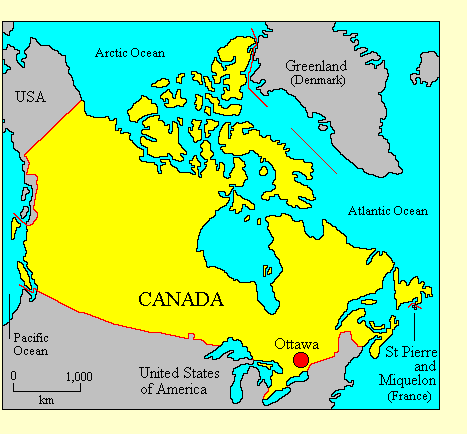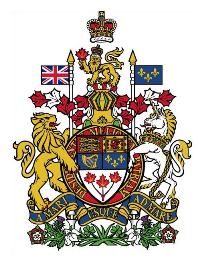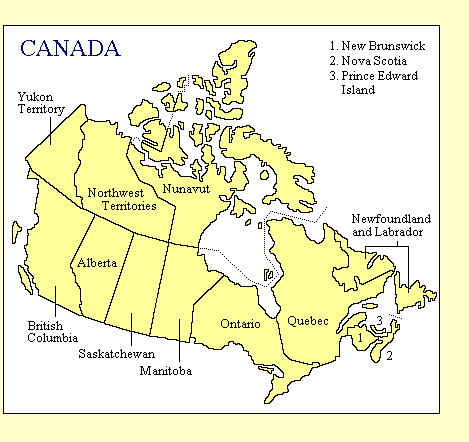

CANADA
• Official name: Canada
• Location: North America
• International organisations: Asia-Pacific Economic Co-operation Forum, Commonwealth of
Nations, Group of Eight, Group of Twenty, North
Atlantic Treaty Organisation, Organisation of American States, Organisation for Economic Co-operation and
Development, Organisation Internationale de la Francophonie, United Nations, World Trade Organisation
• Borders: United States of America
• Coastline: Arctic Ocean, North Atlantic Ocean, North Pacific Ocean
• Land area: 9,976,140 Km2
• Population: 33,900,000
• Annual GDP (PPP) per capita: US$38,400 (2009 CIA estimate). World ranking: 19
• Ethnicity: About 70% of Canadians are of entirely European descent, the largest
groups being those of British (28%) and French (23%) descent. About 4% are of Asian
descent and about 2% are Amerindian. The remainder are of other or mixed background.
• Languages: English and French are the official languages of the national
government, and in all the provinces except Quebec, where French alone is official.
About 23% speak French as their first language, nearly all in Quebec. Outside Quebec,
English is the language of government, business and communications. 15% of the
population speak a language other than English and French.
• Religion: Canada is one of the most secular countries in the world, but over 80%
are at least nominally Christian (Catholic 46%, Protestant 36%). Quebec is traditionally
Catholic. There are growing communities of Moslems, Hindus and Buddhists.
• Form of government: Constitutional monarchy, federal parliamentary democracy. Canada
consists of ten provinces and three territories, all of which have elected legislatures
and constitutional automomy.

• Capital: Ottawa
• Constitution: The Canadian constitution consists of two documents. The
Constitution Act
of 1867 (until 1982 known as the British North America Act) is the foundational
document of the Canadian federation. The
Constitution
Act of 1982 incorporates the Canadian Charter of Rights and Freedoms and creates
a mechanism for amending the Constitution. Before 1982 the British North
America Act was an Act of the British Parliament and could not be amended within
Canada.
• Head of state: Queen Elizabeth II, Queen of Canada. The Queen came to the British
throne on 6 February 1952, and has held the title Queen of Canada since 28 May 1953.
The Queen's functions in Canada are excercised by a Governor-General, appointed by the
Queen on the advice of the Prime Minister. The current Governor-General,
David Johnston, took office on
1 October 2010.
• Head of government: The Prime Minister, appointed by the Governor-General. The
Prime Minister is the leader of the largest party in the legislature and is accountable
to it.
• Legislature: The Parliament of Canada
/ Parlement du Canada is a bicameral legislature, although only one house is
elected. The House of Commons or Chambre
des Communes has 301 members, elected for five-year terms from single-member
constituencies. The Senate or Senat has 104 members appointed by the government.
• Electoral authority: Canadian elections are controlled by
Elections Canada
• Freedom House 2011 rating: Political Rights 1, Civil Liberties 1
• Transparency International Corruption Index: 91.1% (6 of 178 countries rated)
• Reporters Without Borders Press Freedom 2010 Index: 93% (21 of 178 countries rated)
• Heritage Foundation Economic Freedom 2010 Index: 80.8% (6 of 179 countries rated)
Political history
British and French settlement of the east coast of Canada began in the early 17th
century. In 1760 the British captured Quebec from the French, but the province
remained French in language and character. All the Canadian colonies gained internal
self-government with elected assemblies in the early 19th century. French resentment
at British rule broke out in an unsuccessful rebellion in 1837. This led to the
report by Lord Durham on Canadian self-government.

In 1841 Quebec was
united with the English-speaking colony of Ontario as the Province of Canada, but this arrangement was not a
success. As a result, in 1867 Quebec, Ontario and the maritime
provinces became the Dominion of Canada, with an elected federal legislature, and all
the provinces retaining their autonomy. This satisfied Quebec opinion until the 1960s. The
Statute of Westminister of 1931 gave Canada full legislative independence from
Britain, but the link to the British Crown remained. Newfoundland joined the Canadian confederation in 1949.
Quebec nationalism began to resurface in the 1960s. Prime Minister Pierre Trudeau, himself a Quebecker, negotiated a
new constitutional arrangment that placed the Constitution under Canadian control,
established official bilingualism and enlarged the autonomy of the provinces, especially
Quebec. This did not satisfy Quebec nationalists, but the people of Quebec have twice
rejected referendum proposals for independence.
Until 2011 Canadian politics were dominated by the rivalry between the moderate centrist
Liberal Party of Canada and the the moderately conservative
Progressive Conservative Party. The Liberals were generally more successful, producing two long-serving prime
ministers in W L Mackenzie King (1921-26, 1926-30, 1935-48) and Pierre Trudeau (1968-79, 1980-84). The
Progressive Conservatives came to power in 1984, but suffered a heavy defeat in 1993 as a result of the
secession of Canadian Reform Conservative Alliance, a militantly right-wing party. In 2003
these parties reunited to form the Conservative
Party of Canada, which in 2006 formed a minority government led by
Stephen Harper. Harper won a small overall majority at the May 2011
elections.
The 2011 elections were a watershed in Canadian politics. The Liberals and the
Quebec Bloc, which favours independence for Quebec, were almost wiped out.
The New Democratic Party, a social democratic party, swept Quebec and displaced the
Liberals in Ontario and the western provinces, becoming the official opposition.
Updated November 2011
|


